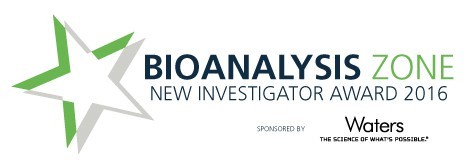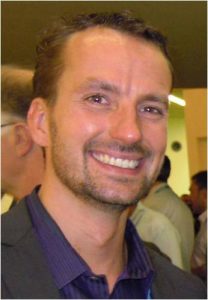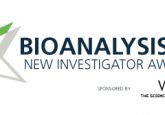2016 New Investigator: Remco Koster

 Nominee:
Nominee:
Nominated By:
Supporting Comments:
What made you choose a career in bioanalysis?
During my study I became very interested in chromatography and the technical aspects of bioanalytical method development. The combination of LC–MS /MS method development with bioanalysis always provided new challenges. In our laboratory setting, bioanalysis is mainly performed for therapeutic drug monitoring (TDM). My goal is to provide better patient care by developing new analysis methods and implementing new sampling techniques, in order to help improving patient outcome and quality of life. At the end, the patient has to benefit from this work.
Describe the main highlights of your bioanalytical work, and its importance to the bioanalytical community.
A LC–MS/MS method was developed for the immunsuppressants (tacrolimus, sirolimus, everolimus and cyclosporin A) in whole blood and dried blood spot (DBS). Compared to the previous analysis technique (immunoassay), the LC–MS/MS method saved 110.000 euro per year in our laboratory, with better performance. The developed analysis method for DBS is currently being clinically validated for implementation in the routine patient setting. This will make bioanalysis and patient care more efficient and more cost-effective, by saving transportation costs and patient/clinician time. The investigation of the binding of sirolimus, everolimus and temsirolimus to the DBS sampling material gave new insights in critical aspects in DBS analysis. The LC–MS/MS analysis of creatinine was a valuable addition to the existing DBS analysis. Since creatinine free blood and thus DBS is not available and cannot be prepared without changing the matrix, this issue was overcome in three different ways. The performed research helped to gain more insight in the critical aspects of different matrices on analytical method development. Finally, by being able to use different matrices for analysis, a personalized choice of matrix may be used in order to best suit the patients’ circumstances.
What is the impact of your work beyond your home laboratory?
The developed LC–MS/MS method for the immunsuppressants (tacrolimus, sirolimus, everolimus and cyclosporin A) in whole blood was implemented in the University Medical Center Maastricht (Maastricht, Netherland) and in the University Medical Center Utrecht (Utrecht, Netherlands). The University Medical Center Utrecht also implemented our creatinine DBS analysis method in their laboratory.
Since also a LC–MS/MS method was developed for the analysis of tuberculosis drugs like rifampicin and clarithromycin in DBS, this offers opportunities to execute projects in developing countries like Indonesia, Bangladesh, Belarus and Paraguay to fight tuberculosis where whole blood sampling is accompanied with great logistic difficulties. These projects have recently started.
Describe the most difficult challenge you have encountered in the laboratory and how you overcame it.
The most difficult challenge was the development of the analysis method for creatinine in DBS. Since creatinine free blood and thus DBS is not available and cannot be prepared without changing the matrix, this issue had to be overcome. Therefore, our analytical method was validated using three different strategies; a 7-point calibration curve using the intercept of the calibration to correct for the natural presence of the creatinine in reference samples; a one point calibration curve at an extremely high concentration in order to diminish the contribution of the natural presence of creatinine and the use of creatinine-[2H3] with an 8-point calibration curve. All three approaches were successfully validated and the one point calibration curve was applied in clinical practice, which proved to be robust and efficient by a minimum number of overhead samples and easy calculation of concentrations.
Describe your role in bioanalytical communities/groups.
I’m a member of the alternative sampling committee of the International Association of Therapeutic Drug Monitoring and Clinical Toxicology (IATDMCT). In 2015 I gave seven presentations (inter)nationally and seven presentations in the years before. I’m part of a team that provides yearly practical courses for research analysts working in Dutch Clinical Pharmaceutical and Toxicological Laboratories and hospital pharmacists in training.
Please list up to five of your publications in the field of bioanalysis (posters and presentations accepted):
- Koster RA, Alffenaar JW, Botma R, Greijdanus B, Uges DR, Kosterink JG, Touw DJ.The relation of the number of hydrogen bond acceptors with recoveries of immunosuppressants in dried blood spot analysis. Bioanalysis. 7(12), 1717–1722 (2015).
- Koster RA, Botma R, Greijdanus B, Uges DR, Kosterink JG, Touw DJ, Alffenaar JW.The performance of five different dried blood spot cards for the analysis of tacrolimus, sirolimus, everolimus, cyclosporin A, ascomycin and temsirolimus. Bioanalysis. 7(10), 1225–35 (2015).
- Koster RA, Alffenaar JW, Greijdanus B, Uges DR. Fast LC-MS/MS analysis of tacrolimus, sirolimus, everolimus and cyclosporin A in dried blood spots and the influence of the hematocrit and immunosuppressant concentration on recovery. Talanta. 115, 47–54 (2013).
- Vu DH, Koster RA, Bolhuis MS, Greijdanusb B, Altenad RV, Nguyenc DH, Brouwers JRBJ, Uges DRA, Alffenaar JWC. Simultaneous determination of rifampicin, clarithromycin and their metabolites in dried blood spots using LC–MS/MS. Talanta. 121 9–17 (2014).
- Koster RA, Greijdanus B, Alffenaar JW, Touw DJ. Dried blood spot analysis of creatinine with LC–MS/MS in addition to immunosuppressants analysis. Anal Bioanal Chem. 407, 1585–1594 (2015).
Please select one publication from above that best highlights your career to date in the field of bioanalysis and provide an explanation for your choice.
Koster RA, Alffenaar JW, Botma R, Greijdanus B, Uges DR, Kosterink JG, Touw DJ. The relation of the number of hydrogen bond acceptors with recoveries of immunosuppressants in dried blood spot analysis. Bioanalysis. 7(12), 1717–1722 (2015).
This study showed that the number of hydrogen bond acceptors of the analyte of interest in combination with the analyte concentration and hematocrit may influence the recoveries in DBS analysis. This somewhat more fundamental research was still very relevant for future optimization of the DBS extraction method. The observed hematocrit effects were addressed by restricting the framework instead of HT based concentration correction. This was done by validating the hematocrit and concentration range in which the results were within 15% bias of the standardized values. This makes the analysis of an extra DBS for HT assessment unnecessary and creates a more efficient workflow.
Find out more about this year’s New Investigator Award, the prize, the judging panel and the rest of our nominees.


